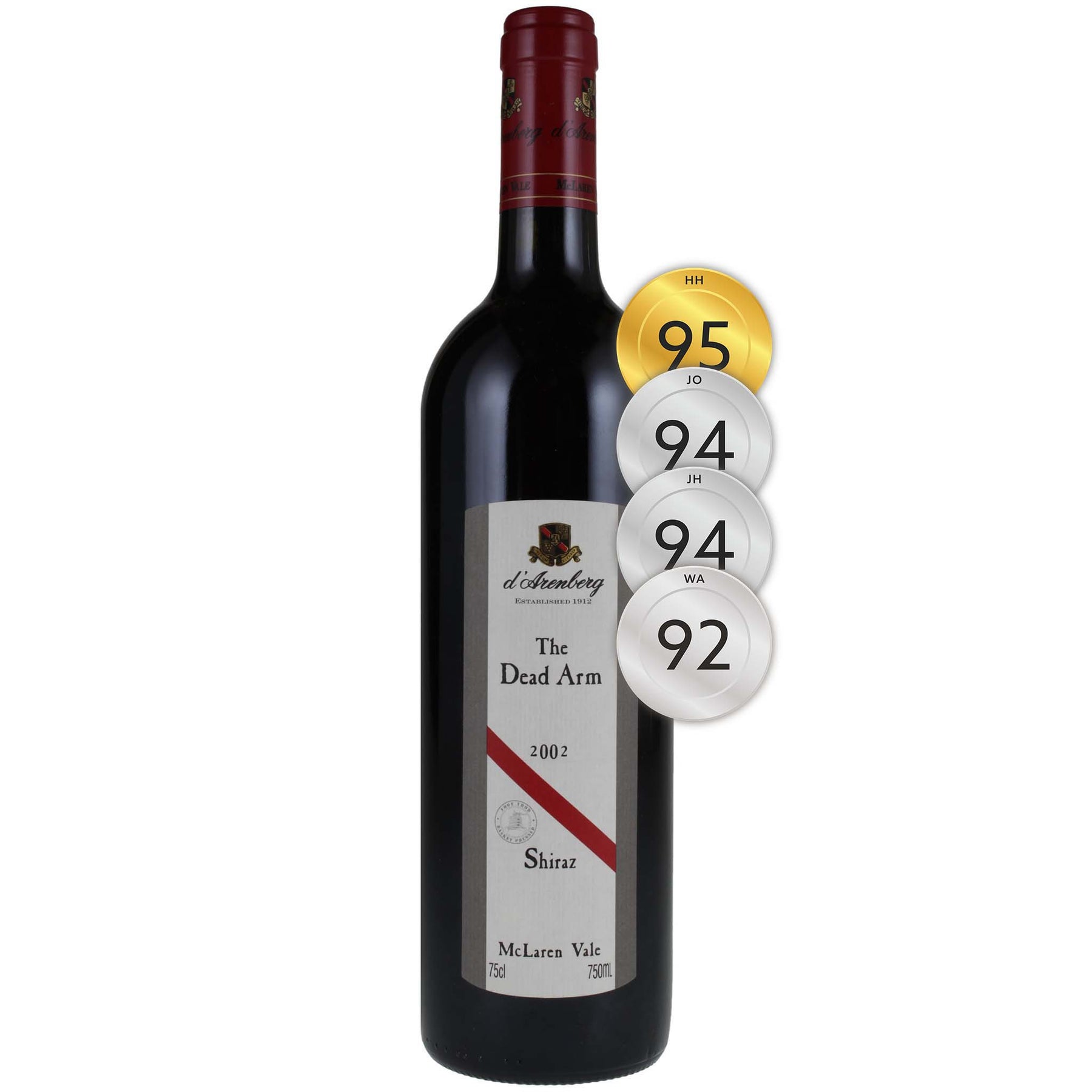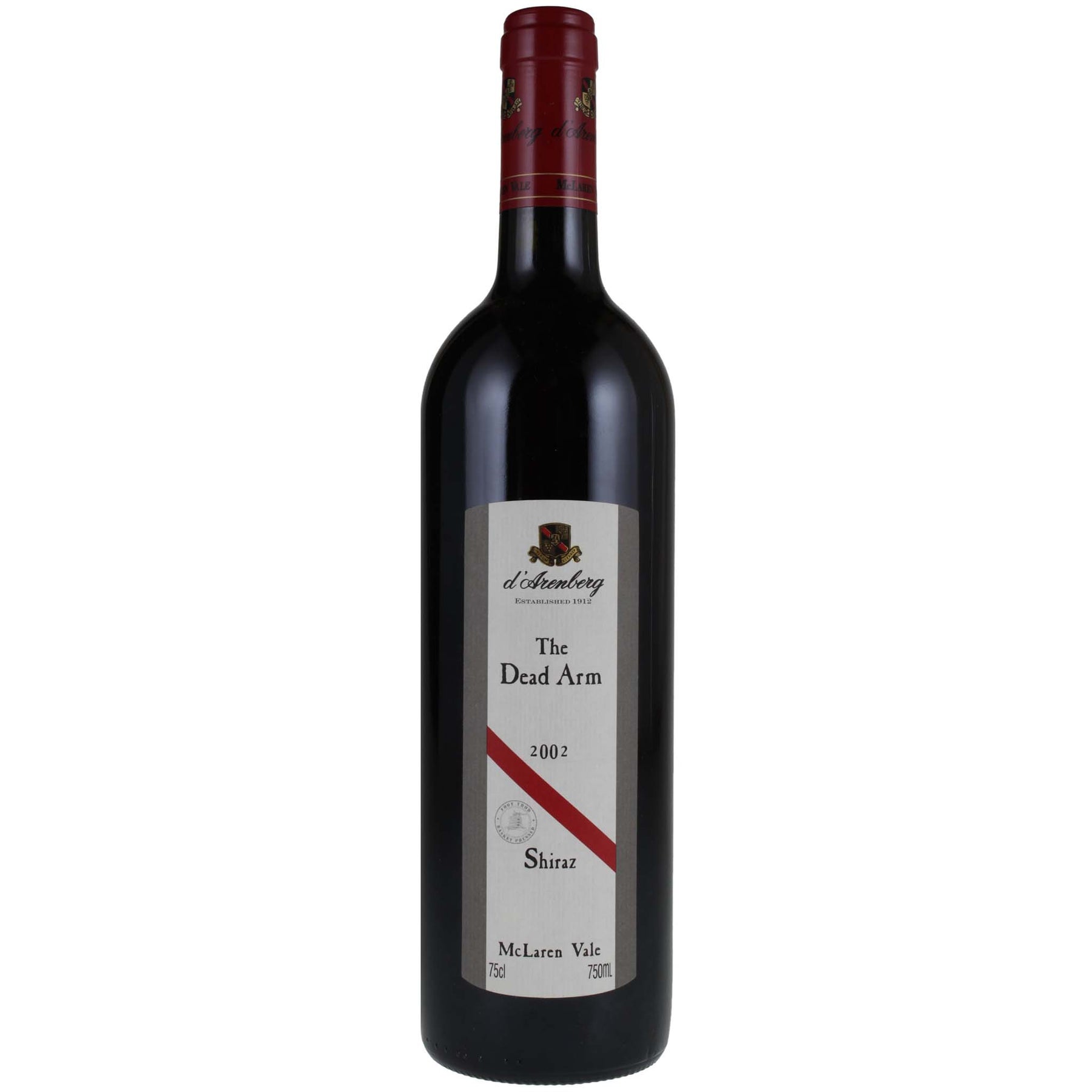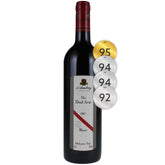

d'Arenberg The Dead Arm Shiraz 2002
Style: Red Wine
Variety: Shiraz
Closure: Cork
d'Arenberg The Dead Arm Shiraz 2002
Warehouse
34 Redland Drive
Vermont VIC 3133
Australia
Producer: d'Arenberg
Country: Australia
Region: McLaren Vale
Vintage: 2002
Critic Score: 95
Alcohol: 14.5%
Size: 750 ml
Drink by: Now
The Dead Arm Shiraz, first released in 1993, is d'Arenberg's flagship wine and has received numerous accolades from wine critics and judges all over the world. The wine is a blend of premium parcels of shiraz sourced from old (some dating back to 1912), extremely low-yielding vines from d'Arenberg's top vineyards.
"Very elegant, intense wine, but less fleshy than some vintages. Lovely wine, very fine, graceful and long. Great stuff." Huon Hooke
The Dead Arm is named after a vine disease caused by the fungus Eutypa Lata that randomly affects vineyards all over the world. Often affected vines are severely pruned or replanted. One half, or an 'arm' of the vine slowly becomes reduced to dead wood. That side may be lifeless and brittle, but the grapes on the other side, while low yielding, display amazing intensity.
Expert reviews
"Deep brick-red colour with a tawny rim. Raisins, crushed ants, a twist of peppermint. Very elegant, intense wine, but less fleshy than some vintages. Lovely wine, very fine, graceful and long. Great stuff. Drink: 2012–2022." Huon Hooke, The Real Review - 95 points (Tasted Feb 2012)
A blockbuster wine from a stellar vintage? That's certainly what everyone expected, but a number of wine critics were disappointed on release. After the voluptuous, ripe and opulent 2001, the 2002 followup was more elegant, tightly focused and backward than they expected. So obviously it's a wine to be put down in the cellar rather than drunk now; but how good/great will it be in the long term? Obviously nobody knows for certain, but the reviews below are certainly insightful, as is the review above from Huon Hooke which was made over 8 years after the wine was released.
"A more elegant, controlled and tightly focused Dead Arm with pleasing fruit and balance, but an unmistakable thread of herbaceousness beneath. Its spicy and lightly smoky fragrance of cassis, blackberries, violets and raspberries is offset by creamy vanilla oak. Silky smooth and velvet-like, its very measured palate of vibrant small black and red berries, licorice and spice culminates in a long, rather minty, eucalypt-like and herbal finish. Drink 2010-2014." Jeremy Oliver - 94 points
"Clean and quite fragrant; abundant blackberry and dark chocolate fruit; controlled extract and good balance. Drink Now-2015." James Halliday, Halliday Wine Companion - 94 points
"The 2002 The Dead Arm Shiraz was a challenge to effectively analyze. After the magnificent 2001, it comes across as lighter-styled, more elegant, but also closed and restrained. Several hours of aeration were beneficial, but this cuvee seems to be playing it close to the vest. However, there is power underneath the tannic structure. A deep ruby/purple color is followed by a backward, full-throttle Shiraz lacking the exuberance, unctuosity, and stunning concentration of the 2001 and 1998. It has noble breeding, but appears to be totally shut down at present. Anticipated maturity: 2009-2020." Robert Parker, Wine Advocate - 92 points
"To do the wine complete justice, I have tried it over a period of the best part of day and have made notes as I went.
First impression upon opening was a bouquet dominated by loads of dusty oak, mushroom, blackberries and a fairly prominent herbaceous undertone. The first sip indicates this wine is a veritable baby and I was committing the worst possible case of vininfanticide. All the components are there but they are not harmonious, to the contrary, the wine is disjointed and jarring. However, when examined closely they are all there in the right proportions and on the plus side, the finish is persistent.
Ninety minutes later coffee essence and an unusual scent that I had trouble positively identifying were the major factors. The unidentified scent seemed like it was "green oak.” On the palate, it was not as jarring as the first sip; it was OK but still very much a baby. Fine-rained dusty tannins, and ripe fruit provide coffee, chocolate, plum and blackberry flavours but there was an herbaceous streak with mint and menthol running through the palate.
After three hours, this wine is really starting to change. On the palate, the fruit is rich and intense with many of the previously mentioned flavours still in play but now there is a real spiciness to it too.
After six hours, the bouquet is dominated by floral violet notes, menthol and spice; it's very attractive and totally unlike the monster that reared its ugly head six hours ago. Tannins are very fine and grip the tongue like a vice, the acid is baby fresh and the fruit is up to the task but now, all the disjointed impression that was evident when first opened has disappeared and the components are more harmonious and in balance. Finish is very long. Spice, coffee essence, multiple berry flavours, plum and chocolate surfing the tasting buds on a (now much tamer and less aggressive, almost Cabernet like) herbaceous under bed with mint and menthol.
After eight hours, now this wine is really singing. The herbaceous streak has receded even further and it is dominated by chocolate, coffee, spice and glorious rich plumy fruit that is full bodied and finishes with great intensity and persistence.
In summary, if those who canned the wine did so from a bottle that was freshly opened, I can understand why. By the same token, those that judged the wine alongside others in a big lineup will also have been justifiably disappointed, especially without significant decant time because it would not show very well at this stage against other wines, which no doubt, would be more attractive and easier to drink in their youth. However, I am very happy I bought this wine and in time, think it will be wonderful. Current rating is Excellent *** for value with room for improvement as the wine matures around the turn of the decade." Ric Einstein, www.torbwine.com
About the winery
 Since 1912 the Osborn family have grown grapes and made wine in the picturesque surrounds of McLaren Vale. Today fourth-generation family member Chester Osborn is at the winemaking helm, making distinctive wines using traditional methods in the winery and the vineyard. All the d'Arenberg wines are handcrafted, the grapes are basket pressed and the red wines are fermented in small batch open fermenters and foot trod.
Since 1912 the Osborn family have grown grapes and made wine in the picturesque surrounds of McLaren Vale. Today fourth-generation family member Chester Osborn is at the winemaking helm, making distinctive wines using traditional methods in the winery and the vineyard. All the d'Arenberg wines are handcrafted, the grapes are basket pressed and the red wines are fermented in small batch open fermenters and foot trod.
In 1912 Joseph Osborn, a teetotaller and director of Thomas Hardy and Sons, purchased the well established Milton Vineyards of 25 hectares in the hills just north of the townships of Gloucester and Bellevue, now known as McLaren Vale.
Joseph's son Frank Osborn left medical school, choosing to forsake the scalpel for pruning shears. He soon increased the size of the vineyard to 78 hectares. Fruit was sold to local wineries until the construction of his own cellars was completed in 1928. Dry red table and fortified wines were produced in ever-increasing quantities to supply the expanding markets of Europe.
In 1943 Frank's son Francis d'Arenberg Osborn, universally known as ‘d'Arry', returned from school, at age 16, to help his ill father run the business, eventually assuming full management in 1957. In 1959 d'Arry decided to launch his own label d'Arenberg, named in honour of his mother, Frances Helena d'Arenberg.
The d'Arenberg wines quickly gained cult status amongst imbibers and judges. The 1968 Cabernet Sauvignon won the Jimmy Watson Trophy at the 1969 Royal Melbourne Wine Show and the 1967 Red Burgundy (Grenache based) was awarded 7 trophies and 29 gold medals in Australian capital city wine shows. By the 1970s d'Arenberg wines had become very fashionable, having gained a significant national and international profile in less than 20 years.
In 1962 Chester Osborn, d'Arry's son and fourth generation family member was born. Chester helped his father in both the vineyards and the cellar floor from an early age. After graduating from Roseworthy College and touring other Australian and European wine regions, Chester took over the reins as Chief Winemaker at d'Arenberg in 1984. He immediately set about returning the family's vineyards to their traditional grape growing practices of minimal inputs and no fertilisation, cultivation and irrigation wherever possible, therefore achieving natural soil flavours with very low yields.
The winemaking processes of the past have been maintained, capturing the unique small-batch character of the wines and the true flavour of the McLaren Vale region. All grapes, red and white, are basket-pressed. The reds are still traditionally fermented with the grape skins (caps) submerged in open wax-lined concrete fermenters utilising the age-old technique of foot-treading.
In 2004 d'Arry was awarded a Medal of the Order of Australia in the Queen's Birthday Honours for his contributions to the wine industry and to the McLaren Vale region. He is justly proud of his achievements in creating an internationally recognised wine brand commonly known as the ‘Red Stripe' due to the distinctive diagonal red stripe that adorns the label.
d'Arenberg cube

In December 2017 a completely new style of cellar door opened at d'Arenberg. This was no converted old stone building or a new building made to blend in with the vines and landscape. This was the d'Arenberg Cube, built to stand out and grab attention. The Cube is a five storey multi-function building set among Mourvèdre vines. The building has the optical illusion of floating in a vineyard, each level with spectacular views.
In 2003 Chester Osborn, d'Arenberg's Chief Winemaker, came up with the idea of building a cellar door with a difference. He had travelled widely through Europe and thought that something distinctive was needed here. The Rubik's cube-like design, heavily inspired by Toyo Ito's Serpentine Gallery Pavilion, reflects the puzzles and complexities of winemaking. It took three years to build the Cube, at a cost of $15 million, $2 million of which was provided as a grant from the South Australian government. It is a multi-use building that features a restaurant known as the d'Arenberg Cube Restaurant, a wine tasting room, a virtual fermenter, a 360-degree video room and the Alternate Realities Museum, which features numerous art installations. The Cube has won numerous Building, Tourism and Restaurant Awards.

South Australia
South Australian is responsible for more than half the production of all Australian wine. It is home to more than 900 wineries across 18 wine regions. The regions are Adelaide Hills, Adelaide Plains, Barossa Valley, Clare Valley, Coonawarra, Currency Creek, Eden Valley, Kangaroo Island, Langhorne Creek, McLaren Vale, Mount Benson, Mount Gambier, Padthaway, Riverland, Robe, Southern Fleurieu, Southern Flinders Ranges and Wrattonbully.
Many of the well-known names in the South Australian wine industry established their first vineyards in the late 1830s and early 1840s. The first vines in McLaren Vale were planted at Reynella in 1839 and Penfold's established Magill Estate on the outskirts of Adelaide in 1844.
South Australia has a vast diversity in geography and climate which allows the State to be able to produce a range of grape varieties - from cool climate Riesling in the Clare and Eden Vallies to the big, full bodied Shiraz wines of the Barossa Valley and McLaren Vale. Two of Australia's best-known wines, Penfolds Grange and Henschke Hill of Grace, are produced here. There is much to discover in South Australia for the wine lover.

